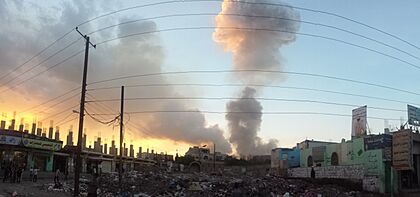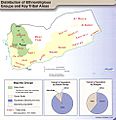Saudi-led intervention in the Yemeni civil war facts for kids
Quick facts for kids Saudi-led intervention in Yemen |
||||||||
|---|---|---|---|---|---|---|---|---|
| Part of the Yemeni civil war and the Iran–Saudi Arabia proxy conflict | ||||||||
 An airstrike in Sanaʽa on 11 May 2015 
Current (February 2024) political and military control in the ongoing Yemeni civil war
Government of Yemen and allies Houthis-led Supreme Political Council Southern Transitional Council and other UAE-backed groups Local, non-aligned forces such as the Hadhramaut Tribal Alliance Ansar al-Sharia and Al-Qaeda in the Arabian Peninsula (AQAP) (See also a detailed map) |
||||||||
|
||||||||
| Belligerents | ||||||||
|
|
|
|||||||
| Commanders and leaders | ||||||||
|
|
|
|||||||
| Strength | ||||||||
|
|
|
|
||||||
| Casualties and losses | ||||||||
|
|
Thousands killed (Aljazeera; as of May 2018) 11,000+ killed (Arab Coalition claim; as of Dec. 2017) |
|
||||||
| 12,907 Yemeni civilians killed (per the LCRD) 8,672 civilians killed, 9,741 injured by coalition's airstrikes (per Yemen Data Project) 500+ Saudi civilians killed (2014–2016) 377,000+ people killed overall (150,000+ from violence) (2014–2021) (UN) |
||||||||
On 26 March 2015, Saudi Arabia, leading a coalition of nine countries from West Asia and North Africa, launched an intervention in Yemen at the request of Yemeni president Abdrabbuh Mansur Hadi, who had been ousted from the capital, Sanaa, in September 2014 by Houthi insurgents during the Yemeni Civil War. Efforts by the United Nations to facilitate a power sharing arrangement under a new transitional government collapsed, leading to escalating conflict between government forces, Houthi rebels, and other armed groups, which culminated in Hadi fleeing to Saudi Arabia shortly before it began military operations in the country.
The first month of the intervention, codenamed Operation Decisive Storm (Arabic: عملية عاصفة الحزم, romanized: Amaliyyat 'Āṣifat al-Ḥazm), consisted of airstrikes on Houthi rebels and a full blockade On 22 April, the Saudi-led coalition declared that it had achieved its initial goals and announced Operation Restoring Hope, which would comprise a "combination of political, diplomatic and military action" while continuing "to prevent the Houthi militias from moving or undertaking any operations inside Yemen". Ground forces were subsequently deployed into the country as part of a broader offensive against both Houthi militants and loyalists of Hadi's predecessor, Ali Abdullah Saleh. Owing to Iran's support of these factions, the conflict is widely regarded as part of the broader Saudi-Iran proxy conflict.
Egypt, Morocco, Jordan, Sudan, and the United Arab Emirates have provided air and ground forces, while Kuwait, Qatar, Bahrain, and Constellis have headed several ground operations. Djibouti, Eritrea, and Somalia opened their airspace, territorial waters, and military bases to coalition forces. At varying stages, the intervention has been backed by the United States, United Kingdom, France, Germany, and Canada. The U.S. provided intelligence and logistical support, such as aerial refueling and search-and-rescue for downed coalition pilots, accelerated the sale of weapons to coalition states, and continued strikes against AQAP. In 2016, American and British military officials were confirmed to have provided advice and training related to Saudi-led airstrikes in Yemen.
The intervention has received widespread international criticism for killing thousands of noncombatants, destroying civilian infrastructure, and intensifying Yemen's humanitarian crisis. Academics also dispute whether it violates Article 2(4) of the UN Charter. By 2019, the conflict was reported as a "military stalemate", and the following year, Saudi Arabia declared its first unilateral ceasefire. On 29 March 2022, the Saudi-led coalition announced that it would cease all hostilities within Yemen to facilitate political talks and peacekeeping efforts; Houthi and Saudi officials subsequently began bilateral peace talks mediated by Oman under UN auspices, and most restrictions on commercial goods were lifted by April 2023. As of April 2024, open hostilities have largely ceased, though negotiations are ongoing due to complications caused by Houthi attacks on Red Sea shipping since October 2023.
Images for kids
-
King Salman of Saudi Arabia and Saudi Foreign Minister Adel al-Jubeir meet with U.S. Secretary of State John Kerry in September 2015.
-
Saudi Arabia's UK-supplied Eurofighter Typhoons are playing a central role in Saudi-led bombing campaign in Yemen.
-
Yemen's former president Ali Abdullah Saleh was initially allied with Houthis, until they assassinated him on accounts of treason.
-
Yemen's President Abdrabbuh Mansur Hadi in Riyadh, Saudi Arabia, 7 May 2015
-
Protesters against the US-backed Saudi-led war on Yemen were led away and handcuffed by New York police outside the US mission to the UN on 11 December 2017.












